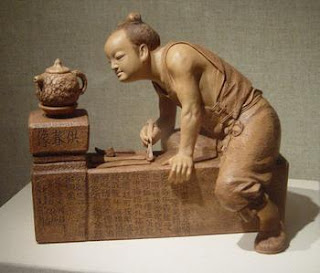It was recorded that broken pieces of pottery work were found in Yixing during ancient times. But only during the early Ming dynasty that the art of teapot making using the purple clay of Yixing was recorded in history. Prior to the first ever recorded piece of Yixing teapot (see 2nd picture), it was told a story that everyone in Yixing is probably very familiar. Legend has it that many years ago in Ting Shu, a town in Yixing, one day a monk appeared from nowhere and uttered some words while running through the streets of the town. Villagers heard him shouting "fortune clay for sale, the poor is not buying, what about the rich?". Nobody understood what he meant and the villagers called him the mad monk. Some old villagers followed him as he ran towards a valley in a mountain and suddenly vanished in thin air. The villagers were then astonished to find the place full of clay of a variety colour, from red, yellow, green, brown to purple. The villagers then took some clay home and found that the clay was indeed very ideal for pottery work. After the potteries were hardened and fired, beautiful colour and texture would appear on the potteries.
 |
| Early pottery work of Yixing |
The art of teapot making using Yixing clay was only recorded during the Ming Dynasty under the reign of Zhend De, sometime around the 1400s. This happened in a temple called Jin Sha (literally means golden sand) where there was a monk who was very skillful in the art of teapot making. He was using the purple clay from Yixing to make teapots for his own use. It was recorded that a scholar went to stay in the temple, probably to study and prepare for the imperial exam. He brought along with him a servant named Gong Chun who would assist him in his studies. One day, Gong Chun, while hiding behind a tree, saw the monk making teapot using a type of clay. On many occasions, he would hide himself and secretly watch the monk making teapots. On one occasion, the monk left after shaping the teapot. Gong Chun went over and retrieved some remnants of clay left behind by the monk. He began to make teapot using his bare hand (as he had no tools). As he was beside a very old gingko tree, he modelled the teapot following the patterns on the bark of the tree. He used his fingers to press on the clay to achieve the irregular finishing of the patterns on the gingko tree. Later when the monk discovered that Gong Chun had the skills and ability to make teapot, he than took Gong Chun as his disciple and taught him all his skills. Gong Chun's master was also amazed at his skills and instructed Gong Chun to make teapots for him and his fellow scholar friends. The master would then help Gong Chun to inscribe his name on the teapots. As tea drinking was a fashion among the rich and famous, Gong Chun became an instant success and his teapots were in great demand by all walks of life. Today Gong Chun's teapots were very rare and some of Gong's teapots discovered were actually imitates by his disciples. Gong Chun had three disciples who were also very skillful in the art of teapot making and their teapots were on display in many museums in China as well museums overseas.
 |
| Gong Chun by Grand Master Xu |
 |
| Gong's teapot as discovered by Chu |
In 1924, a man by the name of Chu, while roaming the antique (flea) market in Suchou, discovered a teapot (without cover) with the inscription of Gong Chun behind. As he heard something regarding Gong Chun, he quickly bought the teapot from the owner. The discovery of Gong Chun's teapot created a stir in the world of antiques. Immediately he approached a famous potter at that time and had the cover made to fit the teapot. It was recorded that the British Museum had made an offer of 20000 pounds to acquire the teapot but Chu refused to part with it. It was indeed an honour for any museum to have this teapot as the Gong Chun's teapot was regarded as the world's first ever recorded piece made. Later a renowned artist, a friend of Chu, told him that the cover did not match the pattern of the teapot. So Chu then commissioned another famous potter to have the cover made to match the body of the teapot. Chu in his later years, donated the Gong Chun's teapot to China's national museum as he reckoned this piece of work is a national treasure. The Gong Chun's teapot has now become a classic shape that a lot of potters (young or experienced) will imitate and make it as a form of training. |
| Cowboy teapot |
 |
| Wood Bundle |
No comments:
Post a Comment